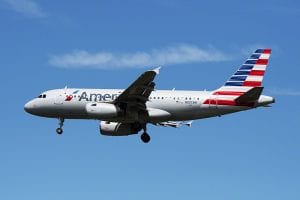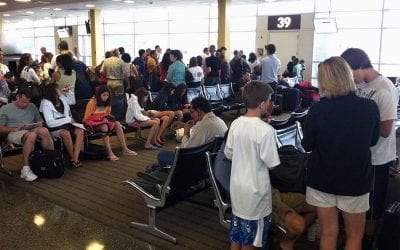As the COVID-19 pandemic continues, many must travel by air and want to know if it’s possible to fly safely

Public health officials continue to tell us to “flatten the curve,” but we need to understand that even if the curve is flattened, the virus will still be infecting people. Is it really safe to fly when the curve is flat?
As U.S. cases rapidly increase, some European countries also are seeing an increase in their virus case numbers
We know that when there is an effective COVID-19 vaccine, coupled with those immune who’ve had the disease (it’s possible, if not likely, that even those who’ve had the virus may need the vaccine to continue their initial immunity) that includes about 70 percent of the world’s population, we can call ourselves safe. If we can say we’re safe to fly before that happens is a tough question.
If you need to fly today, you must assess flight health safety for yourself.
Every traveler must make an air travel safety assessment before making their flight reservations.
To help you make your air travel safety assessment, you first need to understand what the airlines are doing.
Reservations:
Some airlines continue to block some seats in first and business class and middle seats in economy, to enable a small amount of social distancing during flights. The CDC recommends social distancing at six feet or more. On a plane, the typical distance between seats in a row is just 17–22 inches. So, while middle seat blocking stops you from rubbing shoulders with another passenger, you’re still only 15–20 inches apart. While every inch might help you avoid infection, the effect is extremely limited.
Cleaning and Disinfecting:
The airlines have substantially improved the cleaning and disinfection of their planes between flights with extra cleaning on a regular basis. American Airlines, for example, is disinfecting every aircraft, including hand cleaning seat buckles, seats, tray tables and other surfaces. American, like many other airlines, is using an electrostatic spray. Every seven days they’re using disinfectant from EPA’s List N, which is specified to give seven-day protection against COVID-19.
Check-in:
During the check-in process airlines now include a health questionnaire. If passengers answer it honestly, it will help keep infectious passengers off their flights.
Airports:
The airlines, in coordination with airports, have increased the quality and frequency of cleaning gate, ticketing, and service areas, in addition to security, food, and other areas of the airport. Some airlines are checking passengers’ temperature at some airports, but this doesn’t discover asymptomatic, infectious passengers.
Airlines are beginning to run the filtered air circulation system during boarding and deplaning for crew and passenger safety.
Boarding, in-flight, deplaning air cleaning:
Most commercial aircraft today use HEPA filters, which capture 99.9 percent of particles including bacteria, fungi, and viruses like COVID-19 in their air circulation systems. Aircraft cabin air generally passes through the filters 20-30 times per hour. Airlines are beginning to keep their air cleaning systems on during boarding and deplaning, which helps since passengers tend to crowd each other at those times.
In-flight:
All U.S. airlines require passengers and cabin crew to wear face masks at all times, except when eating and drinking. This is one of the three primary ways recommended by public health officials to prevent COVID-19 transmission and is critical on planes.
Airlines have cut back or eliminated food and beverage services to limit crew contact with passengers. The high seatbacks of seating in planes help block the spread of respiratory droplets.
Passengers must take personal responsibility to help improve their health safety while flying and have numerous options to do so.
Reservations:
Try to snag a window seat. That way you’re away from aisle traffic. Try to reserve a seat as far away from a lavatory as possible, as passengers are often waiting there to use it.
READ ALSO ON TRAVELERS UNITED BLOG:
How to choose restaurants in a post-COVID restaurant world
Senators plan to improve passenger confidence on planes
Travelers must pack a sufficient supply of alcohol wipes and hand sanitizer in their carry-on.
Packing:
Make sure you travel with an abundant supply of alcohol wipes and hand sanitizer in your carry-on to use in the airport and during your flight.
Airport:
Wear a mask in the airport and social distance at all times, including at ticketing, security, the gate, and baggage claim.
In-flight:
Before you sit down, disinfect your seat, tray table and the seat back and seat pocket in front of you, with your alcohol wipes. When you eat or drink, do it at times when those around you aren’t, so their masks are on. While seated, keep your overhead air vent open to create a semi-protective air shield around your face. Wash or use hand sanitizer before and after using lavatories.
Baggage Claim:
Once you get your luggage, before you open it or put it in your car, etc., wipe it down with your alcohol wipes.
Wear a mask, maintain social distance, and wash your hands while traveling by air.
Everywhere:
Wear your mask at all times unless you’re eating and drinking. After touching surfaces at the airport, in the plane, etc., remember to not touch your hands to your face until you’ve either washed your hands or used hand sanitizer.
With both airlines’ and airports’ new emphasis on protecting passengers’ health and safety, coupled with what you can do for yourself, air travel can be relatively safe. But each person must judge that for themselves. Each of us must factor in our age and personal health before deciding whether or not to fly.
(Image: American Airlines A319 landing at Philadelphia International Airport. Copyright © 2018 NSL Photography. All Rights Reserved.)
After many years working in corporate America as a chemical engineer, executive and eventually CFO of a multinational manufacturer, Ned founded a tech consulting company and later restarted NSL Photography, his photography business. Before entering the corporate world, Ned worked as a Public Health Engineer for the Philadelphia Department of Public Health. As a well known corporate, travel and wildlife photographer, Ned travels the world writing about travel and photography, as well as running photography workshops, seminars and photowalks. Visit Ned’s Photography Blog and Galleries.



